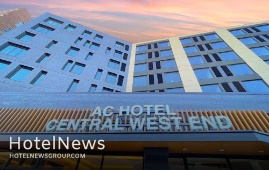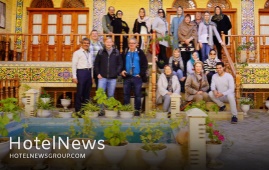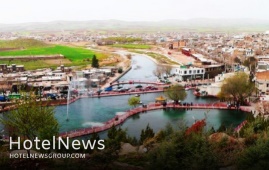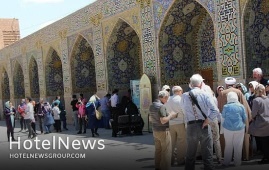
IHG® Hotels & Resorts, one of the world’s leading hotel companies, has announced the signing of a Management Agreement with Dallah Real Estate Company for a Hotel Indigo Resort in Durrat Al Arus, Jeddah. With this signing, IHG continues to expand its lifestyle portfolio in the country to cater to the future demand from new guest segments, seeking authentic Arabian experiences through Hotel Indigo’s neighbourhood story. No two hotel Indigo can be the same, as each has its own specific neighbourhood story embedded in the design, food and service. Due to open in early 2026, the Hotel Indigo Resort will be located in Durrat Al Arus, a recreational neighborhood north of Jeddah, and will be a leisurely drive away from the main city. The resort will be a part of a mixed-use development project consisting of a budding residential community, vast water frontage and man-made lagoons. Located along the Red Sea Coast, Hotel Indigo Resort in Durrat Al Arus will also be a perfect destination for guests to enjoy an active waterfront. IHG and Dallah Real Estate Company, will work in collaboration with renowned design studios and research agencies to weave the ‘Neighbourhood Story’ into the DNA of the hotel. The unique aesthetics of the resort and its service styles will immerse guests into the authenticity of the destination, its local culture, character and history. Along with boldly-designed 271 rooms, the resort will also feature 50 private pool villas, an expansive wellness facility, and home-grown food and beverage concepts that will not only offer a unique perspective to dining in Saudi Arabia – but also catch the interests of foodies and critics alike. Staying true to engaging with the neighbourhood, Dallah Real Estate Company has also partnered with 17Sixty – a marine adventure company that will enable the guests of Hotel Indigo, and residents of Jeddah, to experience marine flora and fauna like never before, keeping sustainability at its core. The company will also provide thrilling water sports activities to the guests. Speaking on the announcement, Haitham Mattar, Managing Director, India, Middle East & Africa, IHG said: “After debuting the brand in Riyadh, we are delighted to sign our second Hotel Indigo property in the country this year – Hotel Indigo Durrat Al Arus in Jeddah. In line with the Saudi Vision 2030 and the country’s Tourism Strategy, our luxury and lifestyle brands are gaining a lot of interest from our partners and investors. We are confident that upon opening, these properties will be equally popular with domestic and international travelers and will add to the authentic experiences guests will be looking for while visiting Saudi Arabia. We are also honored to once again partner with Dallah Real Estate Company, who boast a great deal of expertise in this sector. Together, we look forward to welcoming our guests to this exquisite property when it opens doors in 2026. ” Abdulaziz M.A Yamani, Managing Director, Dallah Real Estate Company said: “Given IHG’s history and strong legacy in the Kingdom, we are pleased to partner with them to offer our Saudi travellers and international guests a premium and authentic stay experience at Hotel Indigo Durrat Al Arus. The hotel will be positioned as a holistic destination for guests looking for adventure and an experiential stay. We are confident that this partnership will not only offer the best-in-class service to guests but also bring value to the business from IHG’s global systems and loyalty programme.” IHG currently operates 37 hotels in Saudi Arabia across five brands including InterContinental, Crowne Plaza, Holiday Inn, Staybridge Suites and voco. A further 23 hotels are in the development pipeline, due to open within the next three to five years.
Create: Dec 22, 2021 Edit: Dec 22, 2021 International News
AC Hotel St. Louis Central West End (215 York Ave, St. Louis, MO 63108), a seven-story 192-room hotel, is now open after a multi-million dollar, ground-up build by St. Louis’ Koplar Properties in partnership with Homebase Partners and Concord Hospitality Enterprises. Located in the Central West End neighborhood of St. Louis, Missouri, the hotel sits in the heart of the city’s upscale retail district and at the eastern edge of Forest Park. The 94,300 square-foot hotel features a state-of-the-art fitness center, small meeting and event space, and curated food and beverage program with inspiration from the hotel’s Spanish and European roots at the AC Kitchen and AC Lounge. The hotel is a new modern and sophisticated destination for culturally-minded travelers and locals alike. This is the first AC Hotel to enter the St. Louis market. Located in the upscale Central West End neighborhood, the hotel is surrounded by sidewalk cafes, smart Italian and Asian fusion restaurants, local coffee shops, chic boutiques and more. Directly across the street sits St. Louis’ award-winning Forest Park with expansive lakes, woods, a golf course and free museums and attractions including the St. Louis Zoo and Saint Louis Art Museum. Steps away are Barnes Jewish Medical Center, Shriners Hospital for Children, Washington University in St. Louis campus and St. Louis Children’s Hospital. AC Hotel St. Louis plans to immerse itself in St. Louis’ local culture, specifically in the arts, attractions and cuisine. HomeBase Partners’ Founder and Owner Andy Holloran said “Together with the Koplar family and Concord Hospitality, HomeBase Partners is excited to bring the AC St. Louis hotel to market in the heart of the vibrant Central West End. Within walking distance to so many restaurants, bars, coffee shops, Forest Park and the incredible medical campus anchored by Barnes Jewish, Children’s and Washington University, the AC Hotel is a much needed and welcome addition!” AC Hotel St. Louis Central West End blends St. Louis’ urban landscape with minimalist, sophisticated design, and features artwork from a local and nationally renowned artist. St. Louis born artist John O’ Hara was commissioned for a signature piece featured in the AC Kitchen and dining area of the hotel. O’Hara is a self-taught artist known for his abstract decorative art. His work is included in public and private collections around the world, including famed designer Michael Kors’ showrooms in Milan, Paris, London and New York. AC Hotel St. Louis Central West End seamlessly fits into the modern and upscale surroundings of the neighborhood, among its world-class art galleries, eye-catching public artwork and stunning turn-of-the-century homes. The sleek design creates a perfectly precise retreat for guests – both inside and out. On the exterior, a natural facade stands out with contemporary wood accents, ivy walls and greenery. Renowned design firm DLR Group worked on the hotel’s interior design, which hosts a blend of European-inspired motif and comfort, with modern decor, touches of natural wood and clean marble throughout the property. Upon entering the lobby, check-in-desks are flanked with a striking leather mosaic in sleek blacks, deep grey and metallic colors. The lobby also includes a welcoming communal space with a massive double-sided fireplace built into a floor-to-ceiling marble wall, which serves as a living room and informal business hub for guests to gather. The space is filled with modern furnishings and artwork, approaching every space with optimal comfort and utility which is intentionally designed to maximize space and minimize clutter. “The hotel design is purposeful, simplistic, and elegant while staying true to our unique aesthetic,” says General Manager Candice Woodring. “We’ve tailored our experiences for business travelers, leisure enthusiasts and locals to all find something at our property. Whether it’s a chic guest room after a long flight or Spanish tapas, signature cocktails and local craft beer with friends, we’ve got something for everyone – business or pleasure.” Furnished with 192 guestrooms, including 114 King sized beds, the design is classic modernism with clean lines, sharp angles, pops of marble and effortless European sophistication. Thoughtful design elements help guests unwind, including plush bedding, a spacious workspace, open closet concepts intuitively designed to create ease of access and visibility, as well as Korres bath amenities made with natural ingredients. Each guest room features precisely placed outlets for ultimate ease of access, a personal in-room coffee maker, temperature-controlled smart refrigerator and a safe. Rooms also feature the latest technologies including 55-inch smart televisions with app streaming and free high speed internet access throughout the property. In addition to in-room amenities, each guest floor features a state-of-the-art sustainability-focused hydration station equipped with glass carafes and purified water. Additional amenities include a state-of-the-art fitness center with Peloton, cardio equipment, free weights, and the AC Store, curated with locally-sourced snacks, sweets, beverages and other local products. Self-parking is available in the Argyle garage located directly across the street from the hotel. From breakfast in the AC Kitchen to cocktails and tapas in the AC Lounge, guests will enjoy flavors that are perfectly curated, poured and plated. The hotel’s European sensibility touches every aspect of the guest experience, including on-site dining. Breakfast at the AC Kitchen features gourmet selections such as fresh baked Delifrance buttered croissants, as well as Berkel sliced La Quercia prosciutto. The AC kitchen will also offer a full menu for guest’s and locals to enjoy with items such as Breakfast Cazuela, and Nutella & Orange Belgium Waffles. The AC Lounge provides guests with a warm and inviting atmosphere to enjoy a drink and a bite to eat with an ambient double-sided fireplace, ample cocktail and lounge seating and modern minimalist design. A harmonious gathering place with a touch of influence from its Spanish roots, the AC Lounge features curated European-inspired small plates after 5 p.m. as well as local libations and signature cocktails like its namesake AC-GT (a custom gin and tonic), served in a scientifically engineered cocktail glass with etchings that discreetly guide the perfect ratio of ingredients. AC Hotel St. Louis Central West End will also serve as an excellent destination for business meetings and social events. The hotel has flexible space to accommodate small business meetings, social functions, rehearsal dinners and celebrations. A dedicated conference room looks out to the bustling neighborhood and is equipped with complimentary high speed internet, 137” drop screen and projector, as well as a separate pre-function space. The hotel can provide a distinct area for private meetings and networking events. The property has also partnered with neighboring restaurant, Edera Italian Eatery, to host larger events with chef-curated menus from Edera’s Executive Chef, Andrew Simon.
Create: Dec 22, 2021 Edit: Dec 22, 2021 International News
Cambria Hotels, an upscale brand franchised by Choice Hotels International, Inc. (NYSE: CHH), continues to expand around the country with the official start of construction on the Cambria Hotel Niagara Falls. This is the fourth hotel to break ground in Q4 2021 and tops off a year of growth across the brand with new openings in popular cities like Louisville, Orlando, and Napa Valley, as well as an additional hotel in Nashville, and a fifth hotel in Washington, D.C. The 120-room hotel is expected to open in the Spring of 2023. Representatives from Choice Hotels, franchisee and developer Plati Niagara Inc., and local dignitaries attended the groundbreaking to commemorate the occasion. Located at 311 Rainbow Blvd. in downtown Niagara Falls, New York, the hotel will be two blocks from the world-famous Niagara Falls State Park, which welcomes over eight million visitors annually. Guests will be able to take advantage of popular tourist attractions like the Maid of the Mist boat tour or get closer to the Falls by descending into the Niagara Gorge at the Cave of the Winds. Future guests also will be able to visit the nearby Robert Moses Niagara Power Plant to see how the Falls serves as a hydroelectric power source. The Cambria Hotel Niagara Falls will feature upscale amenities and approachable indulgences that appeal to modern travelers, including: – Indoor and outdoor spaces for relaxation and productive work. – Locally inspired design and décor, reflecting the unique personality and rich history of the surrounding area. – Contemporary and sophisticated guest rooms, complete with design forward fixtures, abundant lighting and plush bedding. – Immersive, spa-style bathrooms with Bluetooth mirrors. – Bar and restaurant featuring freshly made food, local craft beers on tap, wine and specialty cocktails, as well as to-go options. – Multi-function meeting and event spaces. – State-of-the-art fitness center. The Cambria Hotel Niagara Falls will be developed by Plati Niagara Inc., which also owns a Quality Inn in Niagara Falls. There are currently almost 60 Cambria hotels open across the U.S. in popular cities such as Chicago, Los Angeles, New York, New Orleans, and Phoenix, with over 70 hotels in the pipeline.
Create: Dec 22, 2021 Edit: Dec 22, 2021 International News
MCR — the country’s 4th-largest hotel owner-operator — has acquired a portfolio of six premium-branded hotels in Texas and New Mexico, known as “smile states” for their location and fast-growing markets. Totaling 603 rooms, the acquisition includes two Marriott hotels (a TownePlace Suites and a Fairfield Inn & Suites) and four Hilton hotels (two Hamptons, a Home2 Suites and a Tru). All were built in the last four years and nearly 40% of the portfolio (by room count) is specifically an extended stay, all-suite product designed to cater to longer-term guests. Five hotels are in the Dallas-Fort Worth metroplex, the 2nd-fastest-growing major city in the country. The sixth sits in the arts and culture hub of Santa Fe, New Mexico. Planning your next trip to the South or Southwest? Smile – MCR has you covered! Located in the heart of downtown Fort Worth directly across from the Fort Worth Convention Center, the 120-room Fairfield Inn & Suites by Marriott Fort Worth Downtown is the perfect place to work and play. Opened in October 2017, the hotel features a stunning 20-seat bar, super-fast Wi-Fi and a second-floor patio with city skyline views. Just 5 minutes down Route 377, you’ll find 128 suites with fully equipped kitchens at the TownePlace Suites by Marriott Fort Worth University Area/Medical Center. The hotel is less than 10 minutes away from Texas Christian University, the Modern Art Museum and the Will Rogers Memorial Center. Flying out of DFW Airport? Take your pick! The 94-room Home2 Suites by Hilton Euless DFW West, 79-room Tru by Hilton Euless DFW West and 91-room Hampton Inn & Suites Colleyville DFW West are all just 10 minutes from the 4th-busiest airport in the world. With ultra-plush beds, complimentary hot breakfast and state of the art fitness equipment, you won’t feel far away from home. Further west you’ll find the 91-room Hampton Inn Santa Fe South, an oasis of comfort in the New Mexican desert. Located along State Road 14, the Hampton Inn provides direct access to Santa Fe’s historic downtown. Itching to explore? Check out Meow Wolf, the world-renowned art collective featuring 200-plus artists. Later, catch the sunset by our cozy outdoor fireplace.
Create: Dec 22, 2021 Edit: Dec 22, 2021 International News
The exchange of tourists between Iran and its neighbors is expected to increase in the months to come, Iran’s deputy tourism minister Ali-Asghar Shalbafian has announced. The official made the remarks during a meeting with Hamad Obaidalla the Chief Commercial Officer of Fly Dubai Airlines on Monday. Increasing tourist exchanges with neighboring countries is on the agenda for Iran following the expansion of the flight network between Iran and the United Arab Emirates, he said. To achieve this goal, the private and public sectors will consolidate their capacities, the official added. For his part, Obaidalla said that currently, Fly Dubai Airlines operates 30 flights a week to Iran, and this capacity will grow to nearly 50 flights in the future. By relying on this capability, tourists can be directed to Iranian tourist destinations effectively, he added. Communication between the private sector of the two countries plays a crucial role in achieving executive strategies, he noted. Back in September, Cultural Heritage, Tourism, and Handicrafts Minister Ezzatollah Zarghami announced the issuance of tourist visas and the flow of foreign tourists to Iran would resume as per President Ebrahim Raisi’s order following 19 months of suspension. Currently, tourist visas are once again being issued to cultivate good grounds of hope for travel insiders. However, months of steep recession have taken its toll. Many travel insiders, hoteliers, and tour operators have faced big dilemmas such as bankruptcy, unemployment, debts, and the prospects of not being competitive on the international level. Only months into the outbreak, Zarghami’s predecessor, Ali-Asghar Mounesan, lamented that the number of foreign travelers to Iran was drastically plunged due to the pandemic. “Tourism of the country was growing before the corona [outbreak], its revenues reached $11.7 billion in 2019, which accounted for 2.8% of GDP, nearing the average share of tourism in the world GDP, which was 3.2 percent,” Mounesan said. He added 8.7 million foreign nationals visited Iran during the [Iranian] year (1398), adding that Iran was ranked as the second fastest-growing country in tourism based on data compiled by the World Tourism Organization. The average of international travels to and from Iran fell by 80 percent during the past Iranian calendar year 1399 (ended on March 20, 2021) from a year earlier caused by various coronavirus restrictions. Optimistic forecasts, expect the country would achieve a tourism boom after coronavirus is contained, believing its impact would be temporary and short-lived for a country that ranked the third fastest-growing tourism destination in 2019. UNWTO’s Panel of Experts foresees a rebound in international tourism in the current year, mostly in the third quarter. However, some experts suggest the rebound could occur only in 2022. The Islamic Republic expects to reap a bonanza from its numerous tourist spots such as bazaars, museums, mosques, bridges, bathhouses, madrasas, mausoleums, churches, towers, and mansions, of which 26 are inscribed on the UNESCO World Heritage list. Under the 2025 Tourism Vision Plan, Iran aims to increase the number of tourist arrivals from 4.8 million in 2014 to 20 million in 2025.
Create: Dec 20, 2021 Edit: Dec 22, 2021 Regional News
Hotels have been around for as long as we can remember, but where in history is the origin of this core sector of the tourism industry? While it might come as a surprise for many, the three oldest hotels in the world are all located in Japan and have been operating for hundreds of years. While Japan can boast this very interesting fact, the real champion of historic accommodation facilities is Europe with a large variety of old hotels. In this context, Tourism Review presents the top 10 oldest hotels on the Old Continent – each country represented by only one hotel. Hôtel Cour du Corbeau (France), est. 1528 Located in the heart of Strasbourg and a stone's throw from the cathedral, the Cour du Corbeau is one of the oldest hotels in Europe, being in operation since the beginning of the 16th century. At the same time, it is also one of the most beautiful architectural ensembles of the Renaissance period. The city-owned hotel offers 63 luxurious rooms to its guest, guaranteeing top-notch comfort and an experience to remember. Hostal dos Reis Católicos (Spain), est. 1499 Owned by the Paradores chain (in the ownership of the Spanish government), the Hostal dos Reis Católicos was built as a royal hospital to accommodate pilgrims traveling to Santiago de Compostela. Today, it continues to welcome visitors from all parts of the world in more than 100 rooms and boasts incredible luxury in the heart of one of Spain’s most important cities. Hotel Damier (Belgium), est. 1398 Located on the Grote Markt square in Kortrijk, Damier boasts an impressive history. The first mention of the hotel dates back to the 14th century, with the building boasting an astonishing Rococo façade from 1769. Today, the hotel offers 65 luxurious rooms that will certainly impress even the more demanding individuals. Hotel De Draak (Netherlands), est. 1397 Founded in 1397 and located in the historic center of Bergen op Zoom, Hotel de Draak is the oldest hotel in the Netherlands. It is possible that the hotel is even older, but a huge fire destroyed the city archives in the same year. It is currently owned by the Hazen family and boasts an impressive 62 rooms which provide the guests with fine comfort and luxury. Zum Roten Baeren (Germany), est. 1387 Labelled as the oldest hotel in Germany, the first mention of the Zum Roten Baeren hotel in Freiburg dates to 1387, with the building itself being one of the oldest ones in the city. The guesthouse has been a social center of the city for years and today it has 25 rooms, 20 employees and the ambition to appeal more to the public with its historic charm. Hotel-Gasthof Löwen (Lichtenstein), est. 1380 The Löwen has been offering its services in the hospitality industry since 1380, thus being the oldest hotel in the country. Today the hotel offers elegantly furnished rooms, organization of events and conferences and provides its guests with a gastronomic experience in the form of a restaurant to top it all off. Gastagwirt (Austria), est. 1380 The family led Gastagwirt hotel has been firmly rooted in Eugendorf, in the Salzburg region, for over 700 years. As early as 1380, the "irrevocable, indispensable and forever hereditary liquor license" was awarded to the guesthouse with a letter and a seal. In the present day, the hotel provides fine accommodation services, but especially some of the best seminar and meeting services and facilities in the country. Hotel Interlaken (Switzerland), est. 1323 Hotel Interlaken in Switzerland is also among the oldest hotels in Europe. It was opened in 1323 and was initially meant to be a guesthouse for visitors of the local monastery, while later it was a part of the administration of the region. Today, the family led hotel offers 55 rooms, event organization and much more in the heart of Switzerland. Hotel Alte Goste (Italy), est. 1142 The Alte Goste hotel has been in operation since the 13th century, although the first innkeeper known by name was Gild Stainer in 1557. The region itself served as one of the most important connections between the Holy Roman Empire and Italy. Today the hotel offers a large variety of rooms and apartments for a carefree stay in the Puster Valley. The Olde Bell Hotel (UK), est. 1135 The Olde Bell, located in the small town of Hurley in England first opened almost 900 years ago in 1135. Initially, it operated as a guesthouse for visitors to the nearby Benedictine Priory, but throughout the time it gained even more importance up to the point when Winston Churchill and Dwight D. Eisenhower met there during World War II. Today the hotel offers 48 rooms that guarantee the guests a historic experience not to be forgotten.
Create: Dec 16, 2021 Edit: Dec 16, 2021 International News
In addition to a mandatory negative PCR test certificate, international travelers visiting Iran should buy coronavirus insurance, a tourism official announced on Thursday. “Foreign tourists must buy coronavirus insurance from authorized companies when entering the country, and if they suffer from the pandemic in Iran, they will be provided with a place and treatment for 14 days,” Esmaeil Barat said, IRNA reported. In addition to providing proof of vaccination or a negative PCR, inbound passengers must have coronavirus insurance, which differs from the routine insurance coverage purchased by all tourists before the coronavirus era, the official explained. Home to countless cultural and natural travel destinations, Iran achieved good growth in attracting foreign tourists over the past couple of years but the epidemic shut down its tourism, as in many other countries, Barat said. Iranian Tour Operators Director Ebrahim Pourfaraj said earlier this month that the restoration of tourism flow to the country is very important for Iranian tour operators and travel insiders. “At the moment, we are not thinking about revenues, but we are looking for the beginning of the tourist flow to the country and renew our links [with international fellows],” Pourfaraj said. His comments came after months of steep recession triggered by massive coronavirus restrictions which led many travel insiders, hoteliers, and tour operators towards bankruptcy, unemployment, debts, and the prospects of not being competitive on the international level. As mentioned by Pourfaraj, Iran has made its best to maintain contact with global tourism markets and companies that worked with Iran in the past, especially since virtual communication and meetings have thrived. “Following the resumption of the tourist visa, visitors from Russia and France have traveled to Iran and we are currently expecting a smaller number of tourists in Iran due to the current situation in the world,” he explained. Last November, the World Tourism Organization announced that international tourist arrivals to Iran plunged 72% during the first eight months of 2020 when compared to 2019, highlighting the severe impact of COVID-19 as the main factor. Even before the pandemic, Iran’s tourism was already grappling with some challenges, on top of those Western “media propaganda” aimed at scaring potential travelers away from the Islamic Republic. Some experts believe Iran is still somehow “unknown” for many potential travelers due to such a “media war”. They, however, consider bright prospects for the tourism sector of the country if it vigorously pursues comprehensive strategies to counter U.S.-led propaganda and strict sanctions, yet does its best to loosen tough travel regulations. Iran is potentially a booming destination for travelers seeking cultural attractions, breathtaking sceneries, and numerous UNESCO-registered sites. Under the 2025 Tourism Vision Plan, Iran aims to increase the number of tourist arrivals from 4.8 million in 2014 to 20 million in 2025.
Create: Nov 27, 2021 Edit: Nov 27, 2021 Regional News
Nine tourism-related projects, which are planned to be carried out across the western province of Kermanshah are estimated to generate 135 jobs upon their completion, the provincial tourism chief has announced. The projects will be implemented in the cities of Kermanshah, Javanrud, Harsin, and Islamabad-e-Gharb, Jabbar Gohari said on Tuesday. A budget of 2.4 trillion rials ($58.4 million at the official exchange rate of 42,000 rials per dollar) will be channeled into the projects, which include accommodation centers, tourist complexes, traditional restaurants, and hotel hospitals, the official explained. Kermanshah embraces a variety of awe-inspiring historical sites, of which Bisotun and Taq-e Bostan are both on the UNESCO World Heritage list. Inscribed into the base of a towering cliff, Taq-e Bostan comprises extraordinary Sassanian bas-reliefs of ancient victorious kings divide opinions. Late afternoon is the best time to visit, as the cliff turns a brilliant orange in the setting sun, which then dies poetically on the far side of the duck pond. Bisotun is a patchwork of immense yet impressive life-size carvings depicting King Darius I and several other figures. UNESCO has it that Bisotun bears outstanding testimony to the important interchange of human values on the development of monumental art and writing, reflecting ancient traditions in monumental bas-reliefs.
Create: Nov 20, 2021 Edit: Nov 20, 2021 Regional News
Private investors are now constructing a 5-star hotel, which according to local officials would be the “biggest” of its kind in the northwestern Ardabil province. “Construction operation of what would be the biggest five-star hotel in Ardabil province is ongoing in [the touristic region of] Aznav in Khalkhal county,” Khalkhal’s governor said on Tuesday. The seven-story hotel would have 350 beds in an area of 11,000 square meters, Masud Yeganeh said, CHTN reported. Back in January, the provincial tourism chief, Nader Fallahi, announced that more than 150 tourism-related projects are underway across the mountainous province. “The mentioned projects will prepare the province’s tourism sector for the post-coronavirus era when the number of tourists and travelers is expected to rise magnificently,” the official said. Sprawling on a high, windswept plateau, Ardabilis well-known for having lush natural beauties, hospitable people, and its silk and carpet trade tradition. It is also home to the UNESCO-registered Sheikh Safi al-Din Khanegah and Shrine Ensemble. The province is very cold in winter and mild in summer, attracting thousands every year. The capital city of Ardabilis usually recorded as one of the coldest cities in the country in winter.
Create: Nov 20, 2021 Edit: Nov 20, 2021 Regional News
Donald J. Trump’s family business has an agreement to sell its marquee Washington hotel, reaching a deal to fetch at least $375 million for a property that prompted ethical scrutiny and struggled to make money even as it drew steady crowds of lobbyists, lawmakers and Trump loyalists. The deal so far is what is known as a purchase and sale agreement, meaning a final sale of the Trump International Hotel has not taken place and may not happen until early next year, according to three people with knowledge of the matter. The sale of the lease of the hotel, which operates out of a landmark federal building on Pennsylvania Avenue, comes after years of financial losses at the property, which opened in 2016, shortly before Mr. Trump was elected president. Still, with the significant price of the planned sale, the Trump family is expected to turn a profit on the overall investment. The buyer of the lease is CGI Merchant Group, a minority-owned real estate investment firm in Miami, according to the people briefed on details of the pending transaction, which was reported earlier by The Wall Street Journal. CGI is exploring a deal to rename the hotel, based in the Old Post Office building, under the Waldorf Astoria luxury brand. The sale must first be approved by the General Services Administration, the federal agency that controls the property. From the time of its opening, the hotel immediately drew crowds of Trump supporters and favor-seekers. For a businessman president, it was the ideal bridge between his two worlds: a Trump hotel five blocks from the Trump White House. This blurring between Mr. Trump’s business and his presidency fueled attacks from congressional Democrats who charged that he used the property as the hub of an influence-peddling operation.
Create: Nov 15, 2021 Edit: Nov 15, 2021 International News
A number of Russian travel agents and tour operators have recently arrived in Iran for a week-long familiarization tour, Mehr reported on Friday. The group, which entered the Islamic Republic on Thursday through Imam Khomeini International Airport, was scheduled to travel earlier this year following the implementation of Iran-Russia visa waiver for group tours; however, because of coronavirus restrictions, they were forced to postpone the journey, the report added. Supported by Mahan Airlines, the group will tour the southern cities of Kerman, Mahan, Shiraz, and central city of Isfahan as well as the UNESCO-registered Lut Desert in the barren heartland of Iran. The tour will be held observing strict health protocols and social distancing rules. Earlier in June, the former Iranian tourism minister Ali-Asghar Mounesan finalized work on a bilateral visa-free agreement for tourist groups with Russia. In 2017, former Iranian President Hassan Rouhani and his Russian counterpart Vladimir Putin inked a visa-free agreement for tourist groups. A joint technical committee has been developing an action plan for the previously agreed visa-free travel arrangements since then, in order to put the agreement into effect. However, the outbreak of the coronavirus put a halt to the agreement. Based on the 2017 agreement tour groups of 5 to 50 people heading to [easternmost parts of] Russia from Iran or vice versa are granted a visa-free stay of up to 15 days. Back in May, Mostafa Sarvari, who presides over the tourism marketing and advertising office of the Iranian Tour Operators Association, announced many Russian tourists are eager to travel to Iran, recounting his Russian counterparts. “Many [potential] Russian travelers are motivated to visit novel and lesser-known destinations such as Iran that could be a safe and attractive destination,” he said. “According to Russian tourism experts, the feedback from Russian tourists who have traveled to Iran has been very positive, and its reflection, especially on social media, has caused a great deal of enthusiasm and interest.” According to Ebrahim Pourfaraj, who heads the Iranian Tour Operators Association, rounds of negotiations have been held between Iranian tour operators, travel marketers, and their Russian counterparts. “We’ve been commenced talks with some Russian travel agents to put Iranian destinations on their itineraries…. And the Iranian Tour Operators Association has also entered negotiations with Russian unions for outbound tours to attract more travelers from Russia. Pourfaraj says the majority of potential Russian travelers are unaware of the vast tourist attractions that exist in every corner of Iran. “The fact is that Iran’s political and economic relations with Russia are considered as good, but this has nothing to do with attracting tourists because it is directly connected with the Russian people. It is the Russian people who must choose Iran as their destination.” Maya Lomidze, executive director of the Association of Tour Operators of Russia, had told Sputnik that the visa agreement may significantly surge the tourist flows between the two countries, just like it happened when a similar deal was signed between Russia and China. The flow of Iranian tourists to Russia increased by 50-70 percent following the operation of direct flights that connect Iran to St. Petersburg, Moscow, and Sochi, she said. Iran is taking proactive measures in line with the long-term goal of 20 million tourists by 2025.
Create: Nov 9, 2021 Edit: Nov 9, 2021 Regional News
Home to one of the world’s oldest continuous major civilizations, with historical and urban settlements dating back to 7000 BC, Iran seeks to attract more foreign travelers, and in particular, vacationers from China. Iran’s deputy tourism minister on Wednesday stressed the need for all-inclusive fault detection, and identification of effective factors to expand tourism ties with China in a meeting with travel experts from the state-run institutes and the private sector. We should pay attention to the Chinese market in a more pragmatic approach,” Ali-Asghar Shalbafian said in the follow-up session held to formulate new strategies to expand tourism cooperation between the two ancient countries. So far, steps have been taken to examine the Chinese tourism market, but today the (essential) need is to implement executive measures based on [our] fault detection and macro planning,” the official noted. Insignificant numbers of Chinese restaurants, Chinese-language guides, or even inappropriate lodging facilities are deemed to be among the main reasons why Chinese arrivals in Iran fall short of expectations. Some experts believe that part of this failure comes from inside Iran because Chinese restaurants are scanty across the country while the cuisine is of high importance for the majority of the Chinese people. Moreover, Chinese travelers need fluent Chinese-language tour guides whose numbers are limited in the Islamic Republic. Last year, Tehran’s ex-ambassador to Beijing said Iran was seeking to become a tourist destination for millions of potential travelers from China as the two countries are working on a 25-year comprehensive cooperation plan that includes boosting relations in the field of tourism. Speaking in the TV program, Mehdi Safari reminded some 200 million Chinese tourists to visit different countries annually, adding “according to this agreement Iran will become one of the tourist destinations for Chinese travelers so that Iran can attract one to two million Chinese tourists to the country.” This will create a transformation in Iran’s tourism industry and will create jobs and a large market for the handicrafts industry of the country,” he expanded. In 2019, the Islamic Republic waived the visa requirement for Chinese nationals willing to visit the country. The decision was made to attract more foreign tourists to the country; however, it was a unilateral measure, because Iranian tourists visiting China still need visas. Under the 2025 Tourism Vision Plan, Iran is expecting to increase the number of tourism arrivals from 4.8 million in 2014 to 20 million by 2025.
Create: Nov 9, 2021 Edit: Nov 9, 2021 Regional News
